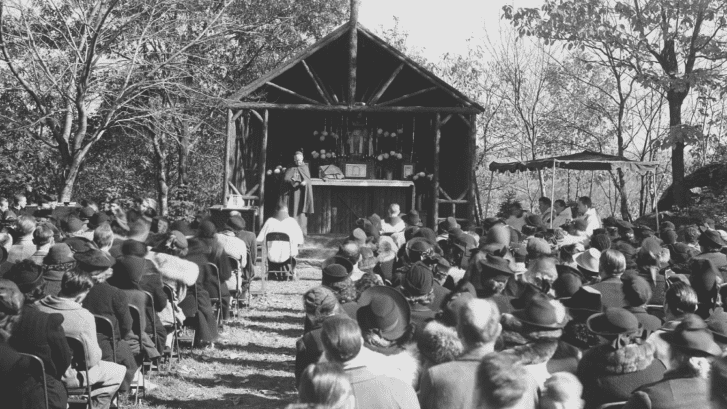Servant of God Father Paul Wattson, SA loved Christmas, not in the tinsel-and-lights kind of way – although his heart certainly glowed with joy during the celebration of the birth of Jesus. His was a deep and respectful love for the day when God became man among the people.
Fr. Paul saw Christmas as both a solemn event and a cause for celebration. It was Fr. Paul who had Graymoor decorated each Christmastime with crèches from around the world, honoring the tradition of St. Francis and the first crèche.
That tradition continues to this day. Just as Fr. Paul intended, the crèches that adorn the grounds of Graymoor each Christmas remind us of the physical sign of the birth of Christ, but also of the beautiful celebrations that take place around the world for the celebration of the Nativity.
For Fr. Paul, the birth of Christ fell in perfect alignment with the incarnational theology he dearly held. Like St. Bonaventure and other Franciscans before him, Fr. Paul viewed the Incarnation as a necessity not simply dictated by fall into sin, but instead by God’s perfect plan for the world. In other words, the Second Person of the Trinity would have graced the world with His presence no matter what, and we continue to benefit from this incredible gift from God.
In honor of Fr. Paul’s love for Christmas, we present his final Christmas Day sermon, which he gave on December 25, 1939, in its entirety:
It was Jesus Himself who said out of the abundance of the heart, the mouth speaketh. How could I speak to you of anything else today but of that wonderful birth, the anniversary of which is being celebrated by [Jew and Gentile] all around the globe at this very moment?
Jesus called Himself the Son of Man, as well as the Son of God. And when, as the Son of God He was made man being born of the Virgin Mary in Bethlehem of Judea, it was to prepare the way for an extension of the Incarnation that it might embrace a vast number of the human race so it could be incorporated in the years to come into the mystical Body of Christ by being born again.
When Nicodemus the ruler of the Jews came to Christ by night, Jesus declared, “Let the man be born again who [enters] through the Kingdom of God.” Nicodemus asked, “How can a man be born again when he’s old? Can he enter a second time through his mother’s womb to be born again? Christ [replied], “Unless a man be born again of water and the Holy Ghost, he cannot enter into the Kingdom of God.”
In the sacrament of regeneration, the divine nature is imparted to the sons and daughters of man. In a mystical way, it is Jesus Himself who is born. St. Paul declared, “It is no longer I that live, but Christ that liveth in me.”
Also, every time Mass is celebrated, Jesus is born again. For when the priest takes bread and wine and says over them the words of consecration, “This is My Body, this is My Blood,” once again the Word is made flesh to dwell among us. The mystery of Bethlehem, the house of bread, is renewed.
Many times Christ has revealed Himself in the Blessed Sacrament to the eyes of devout witnesses. His favorite way of doing so, especially at Christmastime, is to appear as a babe. When one, therefore, receives Holy Communion at Christmas time, he is receiving Jesus Christ under the form of an infant. When Jesus was presented by His mother 40 days after His birth in the Temple of Jerusalem, Simeon took Him in his arms saying, “Lord, now you are letting your servant depart in peace; for my eyes have seen your salvation.” So [too for] the devout communicant that receives the Babe at Bethlehem, not in his arms, but through the portals of the mouth.
The [Redeemer] takes His abode in the very heart of the communicant, thus fulfilling the prayer contained in a popular Christmas hymn:
“O holy Child of Bethlehem! Descend to us, we pray; Cast out our sin, and enter in, Be born in us to-day. We hear the Christmas angels oh, come to us, abide with us, Our Lord Emmanuel!”

